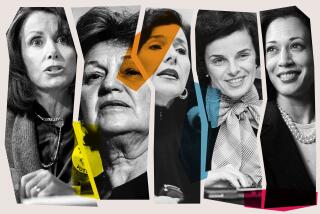With Shift to L.A., Feminist Majority Builds on Momentum
- Share via
The leaders of the Feminist Majority Foundation have decided to stop fudging the issue of the new address in their future. The building that will house the foundation and its newly acquired Ms. magazine is on Beverly Boulevard between Olympic and Pico boulevards, and there’s just no West L.A. about it.
“We’ve decided to say it loud and proud,” says foundation board Chairwoman Peg Yorkin. “We’re moving to Beverly Hills.”
At first glance, Beverly Hills seems an unlikely spot for a building that one foundation official calls “a new international center of feminist research and activism.” Beverly Hills is known for many things, but being a hotbed of the women’s movement is not one of them. Yet in a way, in a very Angeleno way, it is quite fitting. Beverly Hills remains an address that symbolizes success, social validation. And in the past year or so the Feminist Majority has experienced both.
For 15 years, the group has labored successfully in many areas--protecting abortion clinics from potentially violent protesters, increasing the number of women in elected office and law enforcement, and reaching out to university students. But two of their highest-profile campaigns have been for the legalization of mifepristone, the pharmaceutical abortion alternative known as RU-486, and ending the atrocious treatment of Afghan women by the Taliban.
Less than two years ago, the FDA approved mifepristone. And in recent months, the specter of the shrouded and silent Afghan women has become a symbol of the inhumanity of our newest enemy. The foundation played a key role in persuading the Clinton administration to refuse to recognize the Taliban as an official government, but their efforts to increase political pressure and provide humanitarian aid were, for the most part, ignored.
Then the World Trade Center fell and suddenly, after seven years of trying to make the government and the country aware of the dangers the situation in Afghanistan posed, foundation President Eleanor Smeal suddenly found herself a sought-after expert, explaining the history and policies of the Taliban to everyone from local newscasters to National Security Advisor Condoleezza Rice.
In subsequent weeks, as the Justice Department struggled to contain the anthrax crisis, the government once again sought the foundation’s advice. For years, abortion clinics and Planned Parenthood centers had been receiving threatening letters containing white powder. They had developed emergency plans and protocol, which they now offered the government officials.
Atty. Gen. John Ashcroft, in a November news conference, declared such clinic attacks “domestic terrorism.” Since then, the FBI has also begun referring to assaults and threats against abortion clinics as domestic terrorism; the secretary of state has said women’s rights are a human rights issue and even President Bush decried both the treatment of Afghan women and terrorist attacks against abortion clinics.
Then, at the end of last year, the foundation announced that not only had it acquired the 30-year-old Ms., but that it was moving the magazine from New York to Los Angeles. With the magazine comes Gloria Steinem. By gaining her, the foundation--and Los Angeles--now have two of the movement’s biggest players. Smeal is widely recognized as its most dynamic and effective lobbyist, and Steinem remains its most familiar and respected leader.
Popular culture has also mirrored the group’s increasing visibility. “The Shroud of Silence,” a documentary about Afghanistan partially funded by the foundation, began appearing on television in past months; films and plays dealing with life under the Taliban soon followed. On NBC’s “The West Wing,” feminists ruled for a whole episode in which press secretary C.J. Cregg argued--with speeches that could have been written by Smeal--against the funding of a military base in a country that oppresses women. Perhaps not since the Supreme Court upheld Roe vs. Wade in 1973 has the women’s movement had such a presence and impact on American policy.
“I don’t think we’ve ever affected foreign policy before,” said Yorkin. “But if we had not prevented the U.S. from recognizing the Taliban, think of how much worse this all would be.”
Technically, the Feminist Majority is a Washington-based organization, and the staff in the D.C. office is twice as big--28 to L.A.’s 12--but the L.A. office has been much higher-profile, mainly because the foundation has learned how to work the town. When early efforts to draw attention to the plight of Afghan women foundered, Yorkin and foundation Executive Vice President Katherine Spillar convinced then-board member Mavis Leno to spearhead the campaign. With an initial million-dollar donation, and occasional guest appearances by husband Jay, Leno got more attention for the cause in a few months than the organization had gotten in years.
“We have learned the power of the entertainment media,” said Spillar. “They will cover things mainstream papers might not, and they reach so many more people.”
No one understands this better than Yorkin, a former movie and theater producer, who has long put her money where her mouth is. During the ‘80s, she tried, with mixed results, to establish a mid-sized theatrical community in the city where work by women might have an easier time getting produced. When she met Smeal in 1987, she turned her attention to politics.
Five years after co-founding what was then called the Fund for the Feminist Majority, she gave the group $10 million, much of it earmarked to push mifepristone. It remains the largest single donation to a feminist organization.
It was Yorkin and Spillar who convinced the Beltway-oriented Smeal that there had to be an L.A. office for the new group, and one with teeth. Too many politicos, Yorkin said, “think of California as the ultimate gold coast--a base for fund-raising and that’s it.”
“Peg was adamant,” Smeal said. “She said we can’t just fund-raise, we have to have programs.”
It made as much systemic sense as it did geographic. Smeal, a former president of the National Organization for Women, wanted to create an organization that was light on its feet, that would attach itself to a broad range of women’s concerns and had the ability to shift its attentions as women’s needs shifted.
“Women’s groups have become more specialized around issues and geography,” said Steinem. “One of the reasons we thought [the magazine and the foundation] was such a perfect fit is that both the group and the magazine are more oriented to the news, to what needs to be done now.”
According to longtime activist Robin Morgan, the Feminist Majority has been able to successfully do what many other women’s organizations have not: capture the interest of young women while not losing support from the baby boomers. The biggest strength of the group, she said, is its grass-roots activism and its broad-based goals. “We need NOW to be what it is,” she said, “but we also need a fluid, dynamic organization with political sophistication.”
But that fluidity can sometimes work against social movements, which often coalesce with a specific goal and then disperse when that goal is met or defeated. By moving from renter to property owner, the foundation hopes to claim some ground permanently, which many think should be one of the goals of the post-millennial movement.
It’s also important, Morgan said, for organizations like the Feminist Majority Foundation to acknowledge their influence, to remind people that, as with the situation in Afghanistan, they were right in their condemnations.
“We tried to get them classified as terrorists for years,” said Smeal of the Taliban. “We kept saying you cannot have this kind of social instability without international repercussions. They targeted these women because they were Westernized as much as because they were women.”
People need to be aware of that, said Morgan. “If women are canaries in the coal mine then it would be nice if we listened to them once in a while,” she said. “And we need to learn to claim our victories. There’s still an idea that ‘nice women don’t brag.’ But too often the substance of a win gets separated from who initiated it. We need to say: ‘We did this, and here’s what we’re going to do next.’”
Yorkin and Spillar too are enjoying their new street cred, even though they realize the public attention span is short, and politicians’ attention spans even shorter.
“We’re hoping that it will bolster recognition of the need for women’s rights internationally,” said Spillar. “And that people will realize that feminism is everywhere. Despite a concerted effort by some to denigrate and discredit it, it’s very widespread.”
The two women were sitting in the conference room of the West Coast office. On the wall just behind them hang sketches for the remodeling of the new building, which is underway. It looks quite modern, in the way sketches do, and much more spacious than their current quarters. In addition to the magazine offices, there will be room for an extensive library and archives from the women’s movement; a large auditorium that will be used for a new visiting scholars program and lecture series; a training center for the group’s campus and law enforcement programs; and room for general feminist assembly.
When asked about the specifics of the move, the women’s faces fall into the pre-emptive weariness that the image of boxes and moving vans tend to conjure.
“We’ll be there by June,” said Yorkin. “Don’t know how, but we will.”
“It’s been a very busy time,” said Spillar, “but there’s a lot more to do.”
Ask them what exactly and they’ll tell you, in a concise way that is taught by years of having a lot to say and never enough time to say it: campaign finance reform that would allow candidates to draw a salary while running for office using PAC money.
“Most men who run are personally funded somehow,” said Spillar. “Their law firm or corporation continues to pay them because they bring in publicity. But women are often teachers or activists and so they have to quit their jobs to run. So they don’t run.” They would also like to establish a 50/50 law, by which half of all elected bodies would have to be women. “They have that in India,” said Yorkin. “India, for heaven’s sake.”
But first, they intend to continue to push for aid to women living in Afghanistan and the Pakistan refugee camps. “The words are there, but the money isn’t yet,” said Smeal. “We need to make a commitment to a democratic government [there]--I keep hearing the term ‘warlord’ and I don’t know what this means. It’s a term from the 15th century. These women are still poor and uneducated and most of them haven’t taken off the burka. They are terrorized. They do not trust what is going to happen next.”
They also plan to keep reminding the U.S. government that Afghanistan is not the only country in which women are oppressed in the name of religion--Saudi Arabian women, for instance, suffer from the same sort of restrictions. “We need to develop a feminist foreign policy,” said Smeal. “That’s something we’ll be working on in the near future. A comprehensive foreign policy.”
The most important thing the women hope to do now, with their 15 minutes of fame, with the new building and the new magazine, with the enduring commitment and goals, is to show the world once and for all that the equal treatment of women is essential for any modern society.
“Women are not a side issue,” said Smeal. “And most of what we tend to call ‘soft’ issues--education, health care, environmental concerns--are really the hard issues. They are what civilization is based on. And we cannot have women living in the 15th or the 17th century while the rest of the world moves into the 21st. Societies that attempt to do this are not ‘conservative,’ they are abusive and destructive. We need to know that. And fight it wherever we see it.”
More to Read
Sign up for Essential California
The most important California stories and recommendations in your inbox every morning.
You may occasionally receive promotional content from the Los Angeles Times.










